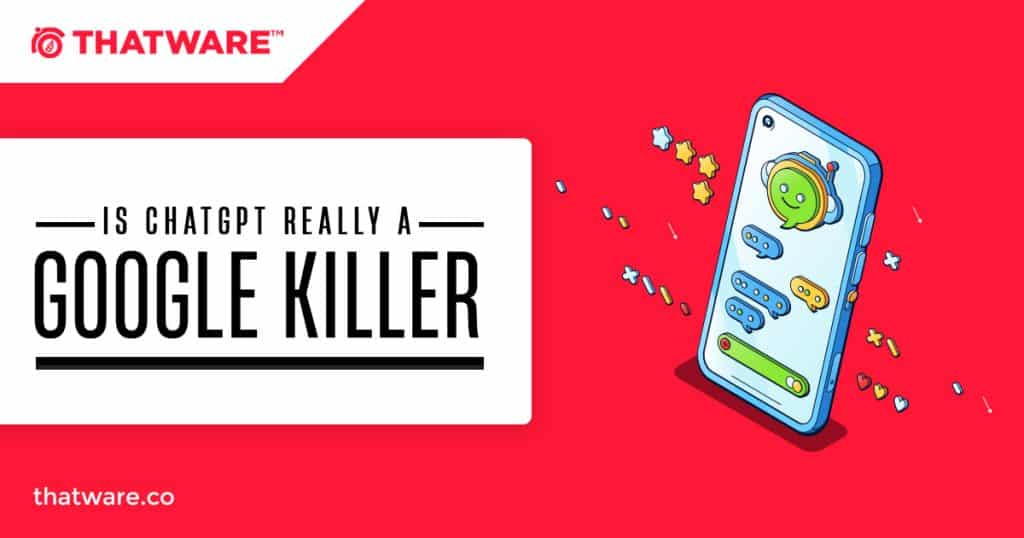SUPERCHARGE YOUR ONLINE VISIBILITY! CONTACT US AND LET’S ACHIEVE EXCELLENCE TOGETHER!
ChatGPT has been touted as a Google killer many times before. It is often compared to the search engine giant. ChatGPT is better than Google because it is faster, more private and has more features. Is ChatGPT the next big thing? Let’s talk about it.

What is ChatGPT?
ChatGPT is a conversation AI software known as a chatbot trained to answer real-life queries. Although the intention is quite similar to search Engines, ChatGPT is much different than that, in the sense that ChatGPT is a dialogue-based software and gives answers in dialogues based on the data it has been trained on, while search engines maintain an index (a database of all relevant documents in the internet that is dynamically ranked based on a pre-defined set of dynamic ranking factors each time a search query is placed.
How can ChatGPT influence Search Engines?
Although Search Engines traditionally provide the most relevant information on the internet based on the search query, recently, Google has made great headways into giving quick answers in terms of Featured Snippets and structured data in SERPs.
This is possible with Google’s recent advances in Natural Language Processing and AI in the form of several updates, including Rankbrain, BERT and Lambda.
Lambda is the most significant as this uses similar Transformer architecture of neural networks, trained on 137B parameters and 1.57 Trillion words among publicly available data and documents.
Is it true that Open AI uses the same Lambda Architecture as Google?
It needs to be more accurate to say that OpenAI uses the same Lambda architecture as Google. The Lambda architecture is a generic architecture for building data processing systems that Nathan Marz first described in his book “Big Data.” It uses a batch, seed, and serving layer to process data in real-time.
The batch layer processes data in batch mode, while the speed layer processes data in real-time using a stream processing system. The serving layer is used to store and query the processed data. Google and other companies have used the Lambda architecture to build large-scale data processing systems.
OpenAI, on the other hand, is a research organisation that focuses on developing and promoting advanced artificial intelligence technologies. The organisation has developed several machine learning models, including the GPT (Generative Pre-training Transformer) model, a natural language processing model that uses the Transformer architecture.
The Transformer architecture is an encoder-decoder architecture that uses self-attention mechanisms to process input data and generate output. It is designed to be efficient and effective for various natural language processing tasks.
Similarity:
Like LaMDA, ChatGPT uses a supervised-learning model, where human AI trainers are given access to model suggestions to craft responses and train the model playing both sides—the user and AI assistant. Following this, the trainers ranked the responses from the chatbot’s conversation with them and the sampled alternative completions based on quality.
What Google Lambda Lacks:
Even though there have been numerous mistakes accounted for by clients on the yield delivered by ChatGPT, one of the more intriguing angles about OpenAI’s model is that the GPT-3.5 engineering utilises a reinforcement learning model (RLHF), a prize-based system dependent on human input, consequently improving it step by step.
Then again, LaMDA doesn’t utilise RLHF.
Evolution of Dialogue-Based Models: Google Lambda and OpenAI’s ChatGPT
Both ChatGPT and Google have been developed as a dialogue-based models. However, the actual feel of a dialogue or conversation is quite different in both cases.
Scale AI’s Riley Goodside compares the outputs generated by ChatGPT and LaMDA, referring to the former as an “unlovable C-3PO”. While the answers from ChatGPT appear to be more of a Q&A format, LaMDA’s responses are friendly and, in reality, “conversational”.
This can be attributed to the fact that LaMDA is trained on dialogues, while ChatGPT is said to have been trained on web texts.
Additionally, OpenAI’s conversational AI has been criticised for producing shallow content which can appear to be lifted from Wikipedia. The AI has also earned criticism for providing incorrect information, generating fake quotes, and referencing nonexistent sources.
Here is a popular reference from Google’s Cassie Kozyrkov, who highlights the flaws of ChatGPT > https://kozyrkov.medium.com/introducing-chatgpt-aa824ad89623
When prompted on how ChatGPT is related to GAN, it promptly answered that it is a variant of GAN, which is grossly inaccurate.
What should have been mentioned in the dialogue was how the model learns from its actions. The response was entirely different and correct when presented with the same prompt. It stated, “ChatGPT uses a neural network architecture known as a transformer, which is designed to process and analyse large amounts of data.”
Access to the Internet
The most important consideration of ChatGPT is that unlike popular AI applications like Google Assistant and Siri, ChatGPT has limited access to the internet.
Here’s ChatGPT’s response when asked about its limitations:
And that training data is before 2021, as per ChatGPT’s home page.
This is further evident when we searched for competitors of Websites like Apple and OpenAI; ChatGPT was able to share a fair response; however, when asked about competitors of newly found popular organisations like SliceLife.
Advanced Functions Like WebScraping
Web scraping is a complicated task. Although ChatGPT cannot explicitly scrape the web, it performs certain Web scraping operations using Python and applications like beautiful soup.
web scrape https://books.toscrape.com/ using Python and beautiful soup
Here’s the code.
And here’s the data extracted.
Web scraping without happening to code is marvellous in my eyes.
Disability to Detect Intent
One of the major drawbacks of ChatGPT is that it cannot detect certain well-known entities and websites on the internet.
For example, when asked about Neil Patel, ChatGPT can quickly detect who Neil Patel is and what he does.
However, when asked about npdigital.com, which is Neil Patel’s Website, ChatGPT cannot identify the same.
Browsing the About Us page section of the website would give a clear relationship between Neil Patel and NPDigital. Google would have easily created the semantic relationship between the two entities and shared a relevant answer. However, the same cannot be done by ChatGPT.
ChatGPT can only answer on data that it was trained. Training needs to be updated to return answers on new data.
On the other hand, Google’s AI was specifically created to tackle new queries it receives daily.
Final Thoughts
Without a doubt, I’m incredibly impressed by ChatGPT. OpenAI has exceeded expectations with this remarkable achievement! I strongly urge everyone to try it; its endless possibilities should be on your radar.
But is it really a Google Killer? Not yet. Google is still way ahead in understanding Natural Language and identifying and training itself with new data on the internet, an ability that ChatGPT lacks.


